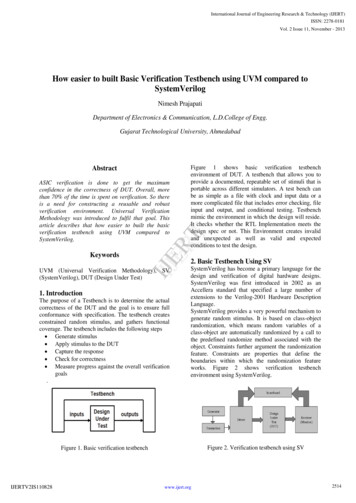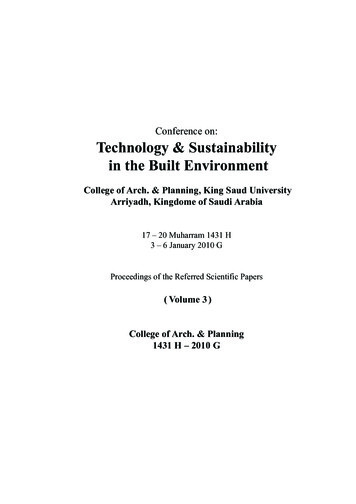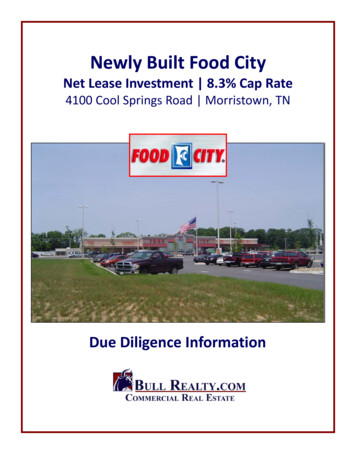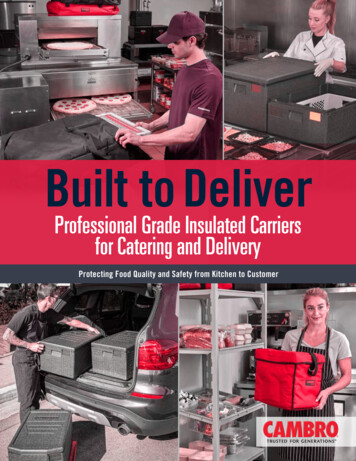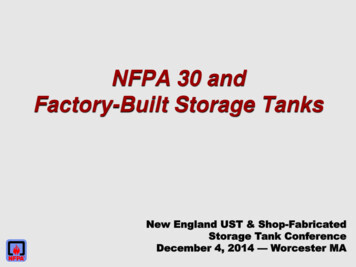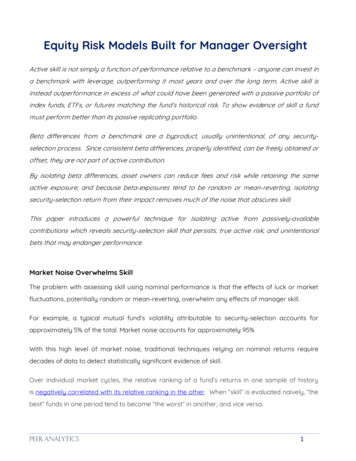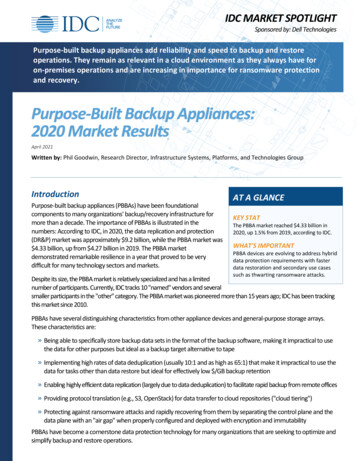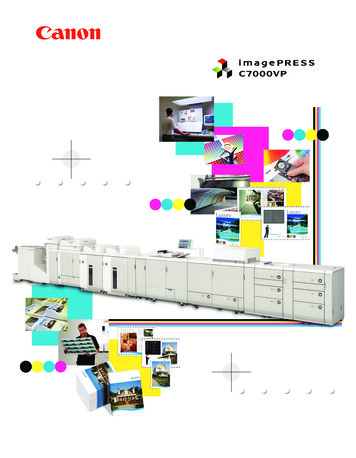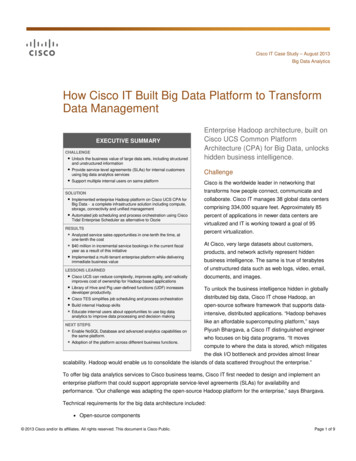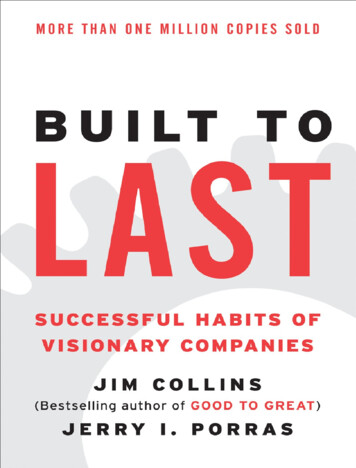
Transcription
BUILT
BUILTTOLASTSuccessful Habitsof Visionary CompaniesJames C. CollinsJerry I. Porras
Dedication
DedicationTo Joanne and Charlene
Contents
ContentsCoverTitle PageDedicationIntroduction to the Paperback EditionPrefaceChapter 1: The Best of the BestChapter 2: Clock Building, Not TimeTellingInterlude: No “Tyranny of the OR”Chapter 3: More Than ProfitsChapter 4: Preserve the Core/StimulateProgressChapter 5: Big Hairy Audacious GoalsChapter 6: Cult-Like CulturesChapter 7: Try a Lot of Stuff and KeepWhat WorksChapter 8: Home-Grown Management
Chapter 9: Good Enough Never IsChapter 10: The End of the BeginningChapter 11: Building the VisionEpilogue: Frequently Asked QuestionsAppendix 1: Research IssuesAppendix 2: Founding Roots of VisionaryCompanies and Comparison CompaniesAppendix 3: TablesAppendix 4: Chapter NotesIndexAcknowledgmentsAbout the AuthorsBack AdAuthor’s NoteMore Praise for Built to LastCreditsCopyrightAbout the Publisher
Introduction to the Paperback
Introduction to the PaperbackEditionOfornBuiltMarch 14, 1994, we shipped the nal manuscriptto Last to our publisher. Like all authors, wehad hopes and dreams for the book, but never daredallow these hopes to become predictions. We knew thatfor every successful book, ten or twenty equally good (orbetter) works languish in obscurity. Two years later, aswe write this introduction to the paperback edition, wend ourselves somewhat astonished by the success of thebook: more than forty printings worldwide, translationinto thirteen languages, and best-seller status in NorthAmerica, Japan, South America, and parts of Europe.There are many ways to measure the success of a book,but for us the quality of our readership stands at the topof the list. Fueled initially by favorable coverage in awide range of magazines and journals, the book quicklyfound an audience and ignited a word-of-mouth chainreaction among thoughtful readers. And that is a keyword: readers. What is the true price of a book? Not thefteen- to twenty- ve-dollar cover price. For a busyperson, the cover price pales in comparison to the hoursrequired to read and digest a book, especially a research-
based, idea-driven work like ours. Most people don’tread the books they buy, or at least not all of them.We’ve been pleasantly surprised not only by how manypeople have bought the book, but by how many haveactually read it. From CEOs and senior executives toaspiring entrepreneurs, leaders of nonpro ts, investors,journalists, and managers early in their careers, busypeople have invested in Built to Last with their mostprecious resource—time.We attribute this widespread readership to fourprimary factors. First, people feel inspired by the verynotion of building an enduring, great company. We’vemet executives from all over the world who aspire tocreate something bigger and more lasting thanthemselves—an ongoing institution rooted in a set oftimeless core values, that exists for a purpose beyond justmaking money, and that stands the test of time by virtueof the ability to continually renew itself from within.We’ve seen this motivation not only in those whoshoulder the responsibility of stewardship in largeorganizations, but also—and perhaps especially—inentrepreneurs and leaders of small to midsizedcompanies. The examples set by people like DavidPackard, George Merck, Walt Disney, Masaru Ibuka, PaulGalvin, and William McKnight—the Thomas Je ersonsand James Madisons of the business world—set a highstandard of values and performance that many feelcompelled to try to live up to. Packard and his peers did
compelled to try to live up to. Packard and his peers didnot begin as corporate giants; they began asentrepreneurs and small business people. From therethey built small, cash-strapped enterprises into some ofthe world’s most enduring and successful corporations.One executive of a small entrepreneurial company said,“To know that they did it gave us con dence and amodel to follow.”Second, thoughtful people crave time-testedfundamentals; they’re tired of the “fad of the year”boom-and-bust cycle of management thinking. Yes, theworld changes—and continues to change at anaccelerated pace—but that does not mean that we shouldabandon the quest for fundamental concepts that standthe test of time. On the contrary, we need them morethan ever! Certainly, we always need to search for newideas and solutions—invention and discovery movehumankind forward—but the biggest problems facingorganizations today stem not from a dearth of newmanagement ideas (we’re inundated with them), butprimarily from a lack of understanding the basicfundamentals and, most problematic, a failure toconsistently apply those fundamentals. Most executiveswould contribute far more to their organizations bygoing back to basics rather than itting o on yetanother short-lived love a air with the next attractive,well-packaged management fad.Third, executives at companies in transition nd theconcepts in Built to Last to be helpful in bringing about
productive change without destroying the bedrockfoundation of a great company (or, in some cases,building that bedrock for the rst time). Contrary topopular wisdom, the proper rst response to a changingworld is not to ask, “How should we change?” but ratherto ask, “What do we stand for and why do we exist?”This should never change. And then feel free to changeeverything else. Put another way, visionary companiesdistinguish their timeless core values and enduringpurpose (which should never change) from theiroperating practices and business strategies (which shouldbe changing constantly in response to a changing world).This distinction has proven to be profoundly useful toorganizations amid dramatic transformation—defensecompanies like Rockwell facing the end of the Cold War,utilities like the Southern Company facing acceleratingderegulation, tobacco companies like UST facing anincreasingly hostile world, family companies like Cargillfacing the rst generation of nonfamily leadership, andcompanies with visionary founders like Advanced MicroDevices and Microsoft facing the need to transcenddependence on the founder.Figure I.AContinuity and Change in VisionaryCompanies
Even the visionary companies studied in Built to Lastneed to continually remind themselves of the crucialdistinction between core and noncore, between whatshould never change and what should be open forchange, between what is truly sacred and what is not.Hewlett-Packard executives, for example, speakfrequently about this crucial distinction, helping HPpeople see that “change” in operating practices, culturalnorms, and business strategies does not mean losing thespirit of the HP Way. Comparing the company to agyroscope, HP’s 1995 annual report emphasizes this keyidea: “Gyroscopes have been used for almost a century toguide ships, airplanes, and satellites. A gyroscope doesthis by combining the stability of an inner wheel withthe free movement of a pivoting frame. In an analogousway, HP’s enduring character guides the company as weboth lead and adapt to the evolution of technology and
markets.” Johnson & Johnson used the concept tochallenge its entire organization structure and revamp itsprocesses while preserving the core ideals embodied inthe Credo. 3M sold o entire chunks of its company thato ered little opportunity for innovation—a dramaticmove that surprised the business press—in order torefocus on its enduring purpose of solving unsolvedproblems innovatively. Indeed, if there is any one“secret” to an enduring great company, it is the ability tomanage continuity and change—a discipline that must beconsciously practiced, even by the most visionary ofcompanies.Fourth, there are many visionary companies out there,and they’ve found the book to be a welcomecon rmation of their approach to business. Thecompanies in our study represent only a small slice ofthe visionary company landscape. Visionary companiescome in many packages: large and small, public andprivate, high pro le and reclusive, stand-alonecompanies and subsidiaries. Well-known companies notin our original study such as Coca-Cola, L.L. Bean, LeviStrauss, McDonald’s, McKinsey, and State Farm almostcertainly qualify as visionary companies, and others likeNike—not yet old enough—will probably enter thatleague. But there are also a large number of less wellknown visionary companies, many of them private andsomewhat reclusive. Some are older, well-establishedcompanies, such as Cargill, Edward D. Jones, Fannie
Mae, Granite Rock, Molex, and Telecare. Others are upand-coming companies, such as Bonneville International,Cypress, GSD&M, Landmark Communications, Manco,MBNA, Taylor Corporation, Sunrise Medical, and WLGore. The business press tends to rivet our attention onthe Icarus companies—high-pro le rms either on theway up or the way down. We regularly come in contactwith a very di erent group of companies—solid, payingattention to the fundamentals, shunning the limelight,creating jobs, generating wealth, and making acontribution to society. We feel optimistic as we seethese companies—and there are a lot of them—maketheir way in the world.BUILT TO LAST IN A GLOBAL, MULTICULTURALWORLDGiven that seventeen of the eighteen visionary companieswe studied for Built to Last have their headquarters inthe United States, we were unsure how the basicconcepts would play in the rest of the world. Sincepublication we’ve learned that the central concepts inBuilt to Last apply worldwide, across cultures and inmulticultural environments. Between the two of us,we’ve traveled to every continent except Antarcticadelivering seminars and lectures and working withcompanies. We’ve worked in a wide variety of countrieswith distinct cultures, including Argentina, Australia,
Brazil, Chile, Colombia, Denmark, Finland, Germany,Holland, Israel, Italy, Mexico, New Zealand, thePhilippines, Singapore, South Africa, Switzerland,Thailand, and Venezuela. And, although we have not yettraveled extensively in all parts of Asia, the book has hada strong reception there, with translations in Chinese,Korean, and Japanese.The aspiration to build an enduring great company isnot uniquely American; we’ve met clock-builders inevery culture. Enlightened business leaders around theglobe intuitively understand the importance of timelesscore values and a purpose beyond just making money.They also exhibit the same relentless drive for progresswe found in those who built the American visionarycompanies. We’ve seen BHAGs in Brazil, cult-likecultures in Scandinavia, “try a lot of stu and keep whatworks” strategies in Israel, continuous self-improvementin South Africa. And the best organizations everywherepay close attention to consistency and alignment.The fact that we primarily studied U.S.-based rms forBuilt to Last re ects our research methodology morethan the global corporate landscape (we assembled ourlist of visionary companies by surveying 700 CEOs ofcompanies based in the United States). Established andup-and-coming visionary companies exist in manycountries—FEMSA in Mexico, Husky in Canada,Odebrecht in Brazil, Sun International in England, Hondain Japan, to name a few. In a new research initiative
designed to replicate the Built to Last analysis andsystematically test the ideas in Europe, Jerry (inconjunction with OCC, a European consulting rm) hasidenti ed eighteen European visionary companies: ABB,BMW, Carrefour, Daimler Benz, Deutsche Bank, Ericsson,Fiat, Glaxo, ING, L’Oréal, Marks & Spencer, Nestlé,Nokia, Philips, Roche, Shell, Siemens, and Unilever.We’ve also seen how the concepts apply tomultinational or global companies that have manycultures within one organization. A global visionarycompany separates operating practices and businessstrategies (which should vary from country to country)from core values and purpose (which should beuniversal and enduring within the company, no matterwhere it does business). A visionary company exports itscore values and purpose to all of its operations in everycountry, but tailors its practices and strategies to localcultural norms and market conditions. For example, WalMart should export its core value that the customer isnumber one to all of its operations overseas, but shouldnot necessarily export the Wal-Mart cheer (which ismerely a cultural practice to reinforce the core value).In our advisory work we’ve been able to helpmultinational companies discover and articulate aunifying, global core ideology. In one company withoperations in twenty-eight countries, most of theexecutives—a cynical and skeptical group—simply didn’tbelieve it possible to nd a shared set of core values and
a common purpose that would be both global andmeaningful. Through an intense process of introspection,beginning with each executive thinking about the corevalues he or she personally brings to his or her work, thegroup did indeed discover and articulate a shared coreideology. They also decided upon speci cimplementation steps to create alignment and bring thecore to life on a consistent basis in all twenty-eightcountries. The executives did not set new core values andpurpose; they discovered a core that they already had incommon but that had been obscured by misalignmentsand lack of dialogue. “For the rst time in my fteenyears here,” said one executive, “I feel like we have acommon identity. It feels good to know that mycolleagues halfway around the globe hold the samefundamental ideals and principles, even though they mayhave very di erent operations and strategies. Diversity isa strength, especially when rooted in a commonunderstanding of what we stand for and why we exist.Now we must make sure this permeates the entireinstitution and lasts over time.”When operating at their best (which they don’t alwaysdo), enduring, great companies do not abandon theircore values and high performance standards when doingbusiness in di erent cultures. As the CEO of a more thanone-hundr
Built to Last reRects our research methodology more than the global corporate landscape (we assembled our list of visionary companies by surveying 700 CEOs of companies based in the United States). Established and up-and-coming visionary companies exist in many countries—FEMSA in Mexico, Husky in Canada, Odebrecht in Brazil, Sun International in England, Honda in Japan, to name a few. In a .
